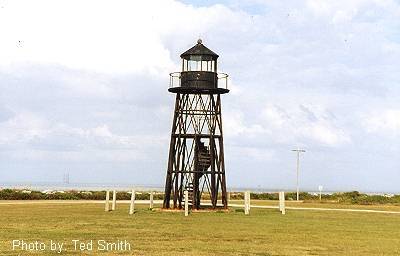 |
Built : 1873 -This was the third lighthouse in this area. See Below in Notes.
Relocated 1966
Type : Steel Skeletal
Height : 120 Feet
Status : Deactivated: 1966
Location : Relocated from mobile bay entrance
Access : Open for public viewing at Ft. Morgan State Park.
Notes: The Fort Morgan
in honor of General Daniel Morgan a Revolutionary War hero was completed
in 1834. The fort is located at the western peninsula that stretches arcross
Mobile Bay's mouth.
The first lighthouse
was completed on the point by June of 1822 at an expense of $9,995.
When attracting a keeper to this remote location was difficult, a soldier
from the fort was assigned to tend the light. The lamps in the lantern
room atop the forty-foot brick tower were finally lit for the first time
on September 29, 1822.
The Mobile Point Light was
visible from ten miles at sea, but shoals kept ships about the same distance
offshore, making it difficult to detect this landfall light. Noted lighthouse
contractor Winslow Lewis was tapped to increase the range of the light.
Lewis prescribed larger reflectors and improved lamps that together would
be mounted in a revolving chandelier to produce a powerful flashing light.
Mariners were not notified of the change in the light's signature from
fixed to flashing, and several sailors confused the Mobile Point Light
with the Pensacola Light, located several miles to the east.
In 1858, a 200-foot-tall
seacoast light was built on Sand Island, three miles offshore from Mobile
Point. No longer needed as a landfall light, the Mobile Point Lighthouse
was downgraded to a harbor light and outfitted with the smallest lens available.
A pair of range lights was also established near the Mobile Point Light
to guide vessels through the shoals and into the bay.
Following the outbreak of
the War Between the States, Confederate forces took control of the fort,
and the Mobile Point Light was deactivated. At dawn on August 5, 1864,
a fleet of eighteen Union ships commanded by Admiral David Farragut approached
the entrance to Mobile Bay. A fierce exchange of cannon fire ensued at
7:30 a.m., during which the Tecumseh, a Union vessel, struck a mine (known
as a torpedo at the time) and sank. The incident threw the Union fleet
into disarray. It was at this critical juncture that Farragut gave his
famous order "Damn the torpedoes, full speed ahead." The remaining vessels
sailed into the bay and succeeded in capturing the fort on August 23. During
the battle for the fort, the lighthouse was struck multiple times, severely
damaging one side of the tower.
After the war, the second
lighthouse was a temporary wooden tower was placed near the crippled
lighthouse, and the old brick tower was demolished. The new structure,
with its sixth-order lens, guided vessels into the bay until a more permanent
lighthouse was built. The third Mobile Point Lighthouse was a 30-foot
iron tower. The red light from the tower's fourth-order Fresnel lens was
first exhibited on February 15, 1873. A new dwelling was also built for
the keeper at this time.
A fourth lighthouse
was a modern steel skeletal tower, was erected at the point in 1963,
and the small iron tower was abandoned. The old tower was cut from its
foundation and ended up at a scrap metal company. For years, the tower
slowly deteriorated in the scrap yard, but fortuitously remained intact.
Eventually, the lighthouse was refurbished and returned to Fort Morgan,
where it is now on display.
| You Can Now | Copyright | Credits |
| Contact Us | usalights Store | Shopping Center |
